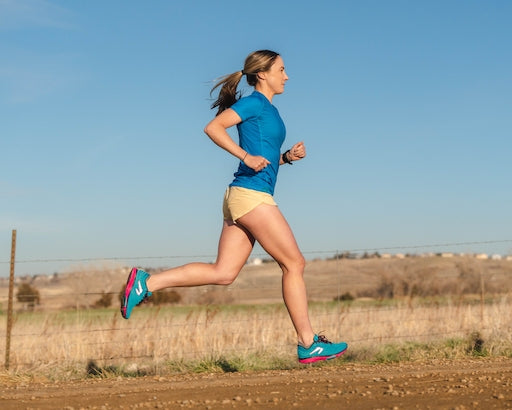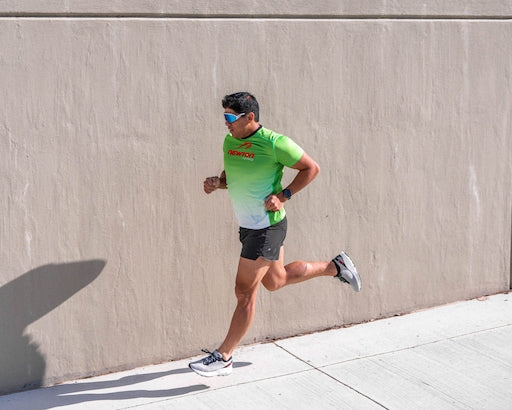
Runner Safety Month, Running After a Natural Distaster
behind the scenes education fitness newton running athletes social responsibility training tips11 October 2024
We are kicking off Runner Safety Month with something a little different this year. We have our Athlete Whitney Dancaster (and Coast Guard veteran) sharing her tips for running after a hurricane. Even if you don’t live in a hurricane zone, these tips will come in handy for anyone looking to go for a run after a natural disaster has hit their run route.

Did you know that 96% of major hurricanes occur between the months of August and October? Unfortunately, this time frame places costal regions at a heightened risk right before the highly anticipated fall racing season.
It's no secret that hurricanes can pose some serious challenges and when it comes to runner's safety during hurricane season, it's crucial to prioritize your well-being while also remaining prepared and informed. In order to continue pursuing training in the aftermath, we simply have to make decisions that prioritize safety.
Once you’ve handled the things you can take care of at home and in your neighborhood, running is an excellent stress relief and with the proper tools in your tool kit, you can ease back into running to preserve your summer training efforts; however, before hitting the road or trails, there are a number of considerations you should keep in mind.

PRIOR TO LEAVING YOUR HOME
- Before venturing out for a run, assess the damage caused by the hurricane in your area. If there are any hazardous conditions, it is advisable to alter your route or consider postponing your run until the area has been deemed safe by local authorities.
- Ensure your visibility by wearing reflective gear or bright clothing. Consider running in the cooler morning temperatures and using a headlamp or carrying a flashlight to improve your visibility.
- Don’t put yourself at risk to heat exhaustion or dehydration. Most likely you’ve been without power and it’s hot. Consider your supplies at home and heed advisements from local authorities to conserve food & water.
- Pay attention to any instructions or warnings issued by local authorities or emergency services. They may advise against non-essential activities, including running or exercising outdoors due to ongoing recovery efforts or potential risks.
- Communicate your plans and share your route, estimated time of return and any alternative routes you may take. This way, someone will be aware of your whereabouts and can provide assistance if needed.
EMERGENCY RESPONSE
- If you encounter emergency vehicles responding to post-hurricane situations, give them the right of way and step aside to allow them to pass safely. Their priority is to provide immediate assistance, so be respectful and understanding of their urgency.
- Emergency crews may need clear access to affected areas for rescue and recovery operations. Avoid running in areas where first responders are actively working.
- After a hurricane, infrastructure such as roads, bridges, and buildings may be compromised or unstable. Exercise caution and avoid running on or near damaged structures. Observe any safety barriers or cordoned-off areas and respect them to prevent accidents or injuries.
WILDLIFE & ANIMALS
- After a hurricane, there can be an increased presence of certain critters and animals that may pose a threat to runners.
- Mosquitoes and other biting insects can multiply rapidly in the stagnant water left behind by a hurricane, increasing the risk of insect-borne diseases such as West Nile virus or Zika virus. Wear protective clothing and use insect repellent when running in affected areas.
- Flooding and displacement of wildlife can bring snakes into areas where they are not typically found. Avoid running through tall grass, wooded areas, or debris piles. Stay on designated paths and be vigilant.
- In regions where alligators are present, heavy rainfall and flooding can cause them to move from their usual habitats. Avoid running near bodies of water or swampy areas, which may attract alligators seeking new territories.
- Hurricanes can disrupt the natural habitats of animals, leading to increased encounters with wildlife such as raccoons, opossums or even larger animals like bears or wild boars. Give these animals space and do not approach them.
OVERHEAD & GROUND HAZARDS
- High winds during a hurricane can cause trees and branches to become weak or fall. Keep an eye out for fallen branches or those hanging precariously from trees. They may pose a risk of falling and causing injury.
- Fallen power lines or cables can be dangerous and pose electrocution risks. Avoid running near or under any downed power lines.
- Hurricanes can leave behind a significant amount of debris, including roofing materials, broken glass, nails, metal objects, and other hazardous materials.
- Strong winds can damage or loosen signs, awnings, and other hanging structures. Be cautious of signs or structures that appear unstable.

STANDING WATER
- It’s best to avoid running through standing water as it can conceal various hazards and may be electrically charged.
- Water is often contaminated with pollutants, chemicals, sewage or other hazardous substances. These contaminants can cause health issues if runners come into contact with or ingest the contaminated water.
- Flooding caused by a hurricane can lead to unstable ground conditions. The ground underneath standing water may be eroded or weakened, making it difficult to determine the stability while running.

Your safety should always be the top priority when training after a hurricane. Adjust your expectations, make sound decisions, be flexible with your training schedule and remember to listen to your body. Stay safe, stay motivated and keep those running goals in sight!
Sincerely,
Whitney Dancaster

